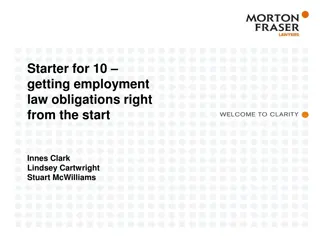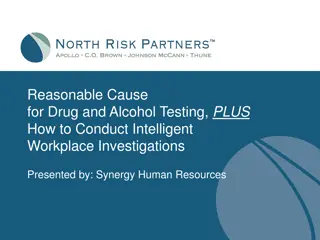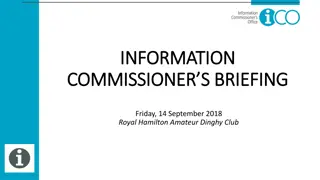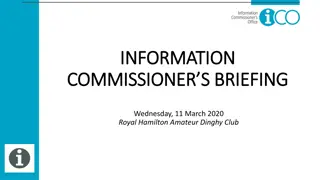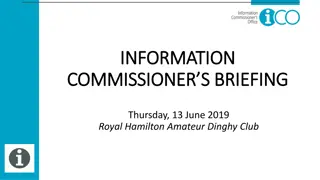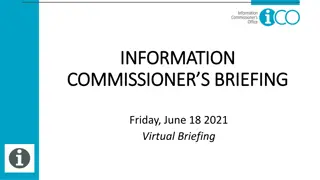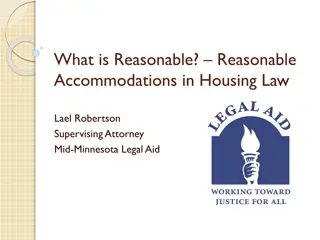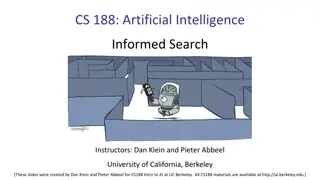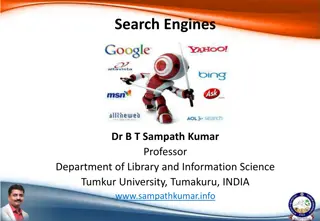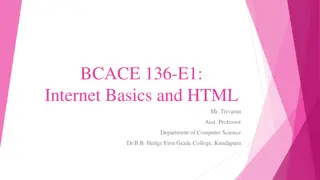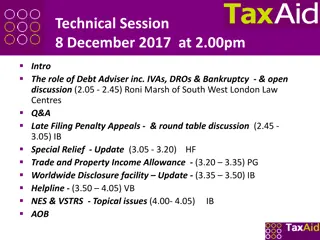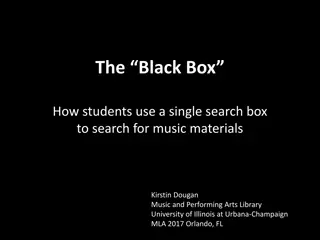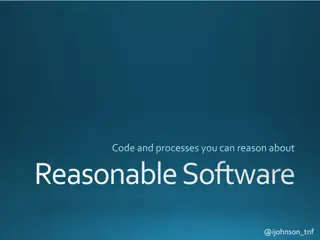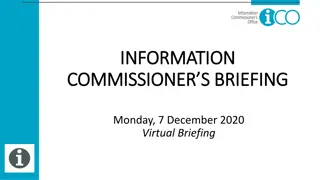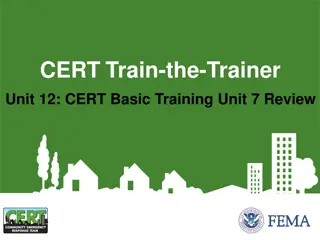Practical Tips for Conducting a Reasonable Search: PATI Compliance
Learn practical tips for conducting a reasonable search in compliance with the Public Access to Information (PATI) requirements. Understand the importance of reasonableness, duty to assist, and narrowing searches. Discover insights on using keywords effectively, documenting the search process, and minimizing risks to ensure thoroughness in information retrieval.
Download Presentation

Please find below an Image/Link to download the presentation.
The content on the website is provided AS IS for your information and personal use only. It may not be sold, licensed, or shared on other websites without obtaining consent from the author.If you encounter any issues during the download, it is possible that the publisher has removed the file from their server.
You are allowed to download the files provided on this website for personal or commercial use, subject to the condition that they are used lawfully. All files are the property of their respective owners.
The content on the website is provided AS IS for your information and personal use only. It may not be sold, licensed, or shared on other websites without obtaining consent from the author.
E N D
Presentation Transcript
INFORMATION INFORMATION COMMISSIONER S BRIEFING COMMISSIONER S BRIEFING Introduction to practical tips on conducting a search Presented by: Gitanjali Gutierrez & LaKai Dill Thursday, 22 February 2024 Dinghy Club
AGENDA AGENDA 09:00 Welcome 09:05 Reasonable search tips 10:15 Break 10:30 Impact of cybersecurity incident on reasonable search 11:00 Wrap-up & evaluations
What PATI requires What PATI requires for a for a reasonable search reasonable search
#1: Reasonableness Not certainty, not perfection, not all efforts Depends on: records sought, circumstances, PATI purposes #2: Held by Take an institutional view Not driven by author Not driven by whether author is still with authority Not driven by ease-of-access
#3: Duty to assist 2-way process: seek to understand information needs Knowledge imbalance favours authority Not about requester having to justify request Accurate, complete and adequate understanding of request #4: Document Duty to record when your efforts do not locate a record Document how and why
Narrowing searches Narrowing searches
Tip #1: Keywords Tip #1: Keywords What keywords could reasonably generate these records? Start with request Consider authority s work, practice, procedures Reach out to colleagues with relevant knowledge Reach out to requester: Consider their response Document our thoughts Inform requester of our conclusion and reasons
Document, document, document Document, document, document Meet what PATI Act and Regulations require Minimise risk of forgetting steps taken or having to re-do search Use search log, especially for physical search or nil results Take full screenshots for electronic search, showing: - keywords, parameters, operators used - locations searched (e.g. folders, shared drive) - number and list of results - search date
Help! Keywords used still generated too many Resist a s.16(1)(c) denial, for substantive and unreasonable interference with other work Meet duty to (offer to) help narrow, before s.16(1)(c) Be honest: was our initial search reasonable? Use parameters and operators, with keywords, to narrow search results
Tip #2: Parameters Tip #2: Parameters Location - e.g. emails sent by Director X limit search to sent folder (plus deleted ) Sender and recipient - e.g. emails on sugar tax between Permanent Secretary and Local Sweets & Co exclude results from other parties Timeframe - e.g. meeting minutes from Jan 2019-Dec 2022 - never open-ended
Tip #3: Operators Tip #3: Operators Combine signs, symbols, words with keywords, to narrow search results Some allow us to limit our searches to items: - contain or exclude certain words - sent to/received from specific recipient/sender - sent or received on specific date or timeframe
Tip #3: Operators Tip #3: Operators exact phrase exact phrase Quotation marks ( ) Helpful when: - using phrase as keyword (e.g. freedom of information v freedom of information) - keywords might generate other results with words beginning with that word (e.g. bud bud, budge, budget, budgetary)
Use freedom of information (no quotation marks) How many results? Get what we were looking for?
Try again using freedom of information What was different?
Example: exact phrase Example: exact phrase Department of Communications mentioning telephone service on 3 March 2023 ANSWER: from: Department of Communications about: telephone service received:3/3/2023
Tip #3: Operators Tip #3: Operators combined phrases phrases combined AND - Must be in uppercase - Generates items with all words placed before and after operator - E.g. freedom of information AND gdpr items containing both phrases, not necessarily in that order
Example: combined words Example: combined words Department of Communications mentioning IDT and holiday ANSWER: from: department of communications about: IDT AND holiday
Tip #3: Operators Tip #3: Operators either/or either/or OR - Must be in uppercase - Generates items with any and all words placed before and after operator - e.g. child OR gdpr items with child, gdpr, or both, not necessarily in that order
Tip #3: Operators Tip #3: Operators excluded words excluded words NOT - Must be in uppercase - Includes items with word/phrase placed before operator, but excludes those with word/phrase placed after operator - e.g. ashley NOT hollis items with ashley but not those with hollis, so will exclude items mentioning ashley hollis
Tip #3: Operators Tip #3: Operators by recipient or sender, & by content sender, & by content by recipient or What you receive: from: name What you send: to: name - e.g. from: jane doe Add about: specific phrase to narrow results even more - e.g. from: Act Now about: gdpr items sent by Act Now where gdpr appears in subject line, body, or attachment contents - e.g. to: john smith
Example: by sender Example: by sender Department of Communications mentioning telephone service on 3 March 2023 ANSWER: from: Department of Communications about: telephone services received:3/3/2023
Tip #3: Operators Tip #3: Operators by date or timeframe timeframe Specific date: by date or received:M/D/YYYY - e.g. received:3/7/2023 items that arrived on 7 March 2023 Multiple dates: (received:M/D/YYYY OR received:M/D/YYYY) - e.g. (received:1/2/2020 OR received:2/1/2020) items that arrived on 2 January 2020 and 1 February 2020 (if items from both dates exist)
Tip #3: Operators Tip #3: Operators by date or timeframe timeframe What arrived before a specific date: by date or received:<M/D/YYYY - e.g. received:<3/7/2023 items that arrived before 7 March 2023 Or use > for items that arrived after a specific date Add = before month for items that arrived on or before a specific date - e.g. received:<=3/7/2023 items that arrived on or before 7 March 2023
Example: before date Example: before date PDP received before 31 January 2020 ANSWER: from:pdp received:<1/31/2020
Tip #3: Operators Tip #3: Operators by date or timeframe timeframe by date or Timeframe (received:>=M/D/YYYY AND received:<=M/D/YYYY) - e.g. (received:>=4/1/2021 AND received:<=3/31/2022) items that arrived on 1 April 2021 and on 31 March 2022 and any between those dates *NOTE: to search for sent items, use sent: instead of received:
Example: timeframe Example: timeframe Act Now about webinars between August and December 2019 ANSWER: from: Act Now about:webinars AND (received:>=8/1/2019 AND received:<1/1/2020)
Tip #3: Operators Tip #3: Operators combining combining Use operators together for a more efficient search Example: emails from Jane Doe about an incident on Tamarind Vale, between 10 August 2022 and 8 February 2023 Type in search field: from: jane doe about: tamarind vale AND (received:>=8/10/2022 AND received:<=2/8/2023)
Remember Remember Results generated from our email search aren t necessarily responsive to PATI request - Outlook search isn t always 100% accurate - Careful review of items generated to determine responsiveness to PATI request still needed - Use parameters and operators to lessen burden of locating and reviewing records
Make use of search options Searching mailbox vs individual folders
Set up your public authority for Set up your public authority for effective searches effective searches Know your public authority Understand your information universe Record keeping approach (shared drive, naming conventions, subject files) Supported, trained, empowered Information Officers
Key points Key points Keywords are key to electronic search Parameters and operators are your friends Document your searches your future self will thank you Start setting up your authority for effective searches TODAY
Impact of cybersecurity Impact of cybersecurity incident on reasonable search incident on reasonable search
Remember Remember #1: Reasonableness What is reasonable for post-attack records? What is proportionate? #2: Held by What is considered held by a public authority after the attack? What is the impact of private or alternative email or other communications channels?
Responding to PATI requests Responding to PATI requests Respond to PATI requests based on what is held at that time Do not place a PATI request on hold while you are waiting for access to be restored Remember the principle of proportionality when determining whether your public authority can access historical electronic records with IDT s assistance
Administrative denials Administrative denials s.16(1)(a) s.16(1)(a) s.16(1)(a) request denied because the record cannot be found after all reasonable steps have been taken to find it (e.g. to restore access to it) Here is where you should consider proportionality Document your efforts Provide a clear and accurate explanation to the requester close the understanding gap
Unofficial systems used for Unofficial systems used for official business official business s.3 of the PATI Act: public authority holds all records that are under its control A record is also defined as information recorded in any form If a communication deals with a public authority s official business and involves someone with a direct connection to the public authority, it will come under the PATI Act
Unofficial or alternative systems Unofficial or alternative systems Must be included in search and steps documented Adopt least intrusive approach that is still effective Recognise window after cybersecurity attack when only communications were through unofficial channels
Unofficial or alternative systems Unofficial or alternative systems Mitigation steps: In crisis, shift from unofficial to alternative forms of communication When unofficial systems are used, copy the official email or phone Ensure that communications through unofficial accounts are transferred into the corporate records
Wrap Wrap- -up up Any reflections? Learn more about the Information Commissioner s reviews, decisions and guidances at ico.bm General questions for ICO at 543-3700 or info@ico.bm


